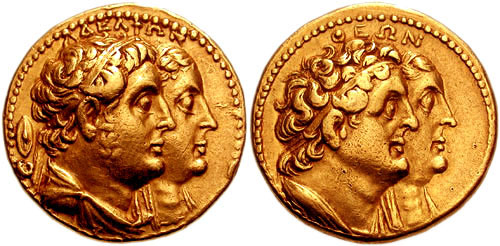All 1 entries tagged Arsinoe
No other Warwick Blogs use the tag Arsinoe on entries | View entries tagged Arsinoe at Technorati | There are no images tagged Arsinoe on this blog
March 01, 2014
A gold octadrachm of the Ptolemaic Dynasty
 |
| Octadrachm of the Ptolemaic Dynasty |
This gold octodrachm was struck at the mint in Alexandria in Egypt, probably under Ptolemy II (this series was likely introduced under Ptolemy II, and was struck until Ptolemy V). The obverse jugate portrait busts are that of Ptolemy II and his sister-wife Arsinoë II (philadelphoi). Both heads are diademed, with that of Arsinoë probably veiled (it is a little difficult to tell). Both busts have a chlamys. The legend within an off-centre dotted border reads ΑΔΕΛΦΩΝ (adelphon), a genitive plural meaning ‘of the siblings’. The reverse depicts the jugate busts of Ptolemy I and Arsinoë I (Soteroi), the parents and predecessors of the obverse subjects. Again, both are diademed and are wearing a chlamys. The legend within the dotted border reads ΘΕΩΝ (theon) meaning ‘of the gods’. This coin presents us with two generations of the Ptolemaic dynasty of Egypt represented on one coin. In light of Ptolemaic iconography up to this issue, this octodrachm is unique, contributing to the on-going iconographic development of Ptolemaic image and ideology.
It was not the everyday bronzes which carried the vanguard iconography of royal ideology, as Ptolemaic bronzes are markedly more conservative and conventional in their iconography, limited to a head of Zeus on the obverse and an eagle on the reverse. Nor are silver types particularly innovative, as they tended also to be similarly iconographically consistent. The more radical and innovative ideological presentations seem reserved, at least early in the Ptolemaic dynasty, for gold issues. From this octodrachm we recognise the preoccupation with retroactive referencing to previous sovereigns and predecessors. But there is also a horizontal reference, in the inclusion of wife and sister, placed behind as they are, but tellingly also parallel to the king. Their co-ruling is suggested, as is the influence of the Ptolemaic queen within the royal court. Familial undertones also come through, with insinuations of loyalty, and secure dynastic succession derived from strong familial bonds. In relation to the ruling king, this reinforces the image of legitimacy in his kingship. The near-identical jugate portraits possess a regal bearing; the duplication betrays aspirations of wanting to be seen as an established royal house. As subjective in interpretation this type may be, they are the result of generations of (generally) dynastic development and (particularly) developments in coin iconography. This process was continued little by little, in experimenting with new ideas of imagery, and ways of presenting and announcing those images, one attribute at a time.
This month's coin was chosen by Sean Gallagher. Sean Gallagher is currently an undergraduate student of Classical Archaeology and Ancient History at the University of Warwick. His interests include religious and cult continuity, numismatics and New Testament Greek.
(Coin image above reprpduced courtesy of Classical Numismatic Group Inc., www.cngcoins.com)
 Clare Rowan
Clare Rowan

 Please wait - comments are loading
Please wait - comments are loading

 Loading…
Loading…

